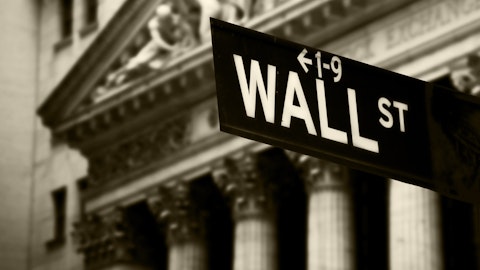The energy sector was unarguably one of the worst performing during the second half of the last year. Owing to the decline in crude oil prices, most energy stocks plunged and extended their losses into the first month of 2016. The previous round of 13F filings also showed a decline of popularity of energy companies among hedge funds and other institutional investors, but a few stocks managed to keep the investors interested, due to their strong balance sheets, which allows them to stay afloat in periods of turmoil and even maintain dividend payments. In this article we are going to take a closer look at five energy stocks that ranked as the most popular among the funds we track and will see if smart money investors made the right call betting on them.
An everyday investor does not have the time or the required skill-set to carry out an in-depth analysis of equities and identify companies with the best future prospects like a hedge fund can. However, it is also not a good idea to pay the egregiously high fees that investment firms charge for their stock picking expertise. Thus a retail investor is better off to monkey the most popular stock picks among hedge funds by him or herself. But not just any picks mind you. Our research has shown that a portfolio based on hedge funds’ top stock picks (which are invariably comprised entirely of large-cap companies) falls considerably short of a portfolio based on their best small-cap stock picks. The most popular large-cap stocks among hedge funds underperformed the market by an average of seven basis points per month in our back tests, whereas the 15 most popular small-cap stock picks among hedge funds outperformed the market by nearly a percentage point per month over the same period between 1999 and 2012 (read the details here).
#5 EOG Resources Inc (NYSE:EOG)
-Hedge Funds with Long Positions (as of September 30): 60
-Aggregate Value of Hedge Funds’ Holdings (as of September 30): $1.54 billion
Exploration and drilling company EOG Resources Inc (NYSE:EOG)’s stock did try to buck the trend by moving up in October, but the gradual decline it suffered during November and December caused it to end the fourth quarter down by 2.76%, while during the full 2015 it lost 25%. The company saw its popularity among hedge funds climb up during the third quarter as three more funds covered by Insider Monkey become bullish on the company during that period.
Although the decline of oil prices has led to several analysts and industry experts to reduce their outlook on exploration and drilling industry, EOG Resources Inc (NYSE:EOG) is among the few energy stocks that currently sports a ‘Buy’ rating from the majority of analysts who cover it.
At a recent industry conference, the company elaborated on how its high density wells at the Eagle Ford shale, which use more sand, are delivering more output than those of its competitors. For the third quarter of fiscal 2015, the company managed to beat analysts’ expectations by declaring EPS of $0.02, compared to an expected loss of $0.30. Even after reducing its stake in the company by more than half to 2.67 million shares during the third quarter, Ken Griffin‘s Citadel Investment Group remained the largest shareholder of EOG Resources among the funds tracked by us at the end of September.
Follow Eog Resources Inc (NYSE:EOG)
Follow Eog Resources Inc (NYSE:EOG)
Receive real-time insider trading and news alerts
#4 Schlumberger Limited. (NYSE:SLB)
-Hedge Funds with Long Positions (as of September 30): 61
-Aggregate Value of Hedge Funds’ Holdings (as of September 30): $2.64 billion
Amid an inverted U-shaped move registered during the quarter, shares of Schlumberger Limited. (NYSE:SLB) ended the fourth quarter nearly flat, but they lost 20% throughout the entire year. Interestingly, during the third quarter -when the stock fell by 19.44% – the number of investors with long positions increased by six and the aggregate value of their holdings also jumped by $483 million. Billionaire Israel Englander‘s Millennium Management made a ninefold increase in its stake in the company to 4.17 million shares during the third quarter.
Even though the oil and gas industry is going through a tough time, Schlumberger Limited. (NYSE:SLB) has continued with its history of dividend payments. The $0.50 per share dividend the company pays translates into an attractive dividend yield of 2.90%. However, this tradition seems to be taking a toll on the company’s balance sheet as its short-term debt has been continuously increasing and its total assets has been continuously decreasing for the past several quarters.
For the last quarter of 2015, Schlumberger posted adjusted EPS of $0.65 on revenue of $7.7 billion, versus consensus estimates of $0.63 in EPS and revenue of $7.78 billion. For the full year, the companyțs revenue slid by 27% on the year to $35.5 billion, on the back of reductions in spending on drilling. However, what surprised investors was the $10 billion buyback program that the company announced together with its financial results. The buyback announcement, alongside cost reductions, offset the stock’s decline since the beginning of 2016, with shares currently trading 1.30% in red year-to-date.
Follow Slb Limited (NYSE:SLB)
Follow Slb Limited (NYSE:SLB)
Receive real-time insider trading and news alerts
#3 Exxon Mobil Corporation (NYSE:XOM)
-Hedge Funds with Long Positions (as of September 30): 61
-Aggregate Value of Hedge Funds’ Holdings (as of September 30): $3.18 billion
After declining for five quarters in a row in tandem with oil prices, shares of Exxon Mobil Corporation (NYSE:XOM) finally managed to change their course by moving up almost 5% during the last three months of 2015. Amid a 10% decline during the third quarter, the ownership of the company among funds covered by us had declined by six. Billionaire David E. Shaw‘s firm, D.E. Shaw, reduced its stake in the company by 34% to 2.55 million shares.
Though the price of oil has continued its decline in 2016, things are looking more optimistic for Exxon Mobil Corporation (NYSE:XOM) now than they were at the start of 2015 thanks to the cost-cutting measures the company has taken in the last few quarters and its decision to not take any major projects until oil prices rebound. Like Schlumberger Limited, Exxon Mobil Corporation has also managed to continue paying dividends to its investors in the current unfavorable scenario. Owing to the decline in its stock price, the current dividend yield of the stock is close to touching 4%. Interestingly, even though its stock has slumped heavily Exxon Mobil Corporation is currently trading at a price-to-earnings multiple of 15.89, which is significantly higher than its historical average.
Earlier this week, Societe Generale reaffirmed its ‘Buy’ rating and $90 price target on Exxon. However, last month, a number of analysts lowered their price targets, including JPMorgan Chase & Co. and Barclays, which reduced their targets to $70 and $80, respectively.
Follow Exxon Mobil Corp (NYSE:XOM)
Follow Exxon Mobil Corp (NYSE:XOM)
Receive real-time insider trading and news alerts
#2 Macquarie Infrastructure Corp (NYSE:MIC)
-Hedge Funds with Long Positions (as of September 30): 69
-Aggregate Value of Hedge Funds’ Holdings (as of September 30): $1.48 billion
Thanks largely to the rise it saw during the first-half of the year, despite an 8.3% fall during the third quarter and 2.76% in the fourth quarter, shares of Macquarie Infrastructure Corp (NYSE:MIC) ended 2015 up by 2.12%. Though the popularity of the company among funds covered by us remained unchanged at the end of September, the aggregate value of their holdings in the company had seen a 28.44% decline during the same period. Jason Karp‘s Tourbillon Capital Partners initiated a stake in Macquarie Infrastructure Corp by purchasing 2 million shares of the company during the third quarter.
Macquarie Infrastructure Corp (NYSE:MIC) is currently one of the best dividend-paying stocks in the energy sector, as it boasts an attractive annual dividend yield of 6.54%. However, analysts and experts are concerned regarding the increasing debt on the company, which they believe can hamper the dividend growth.
In the past few months, some experts have raised concerns about the increasing amount the company’s management is paying itself in fees when the company is not doing so relatively well. For its last quarterly results the Street was expecting Macquarie Infrastructure Corp to report EPS of $0.23 on revenue of $425.92 million, whereas the company declared EPS of $0.13 on revenue of $415.71 million.
Follow Macquarie Infrastructure Corp (NYSE:MIC)
Follow Macquarie Infrastructure Corp (NYSE:MIC)
Receive real-time insider trading and news alerts
#1 Anadarko Petroleum Corporation (NYSE:APC)
-Hedge Funds with Long Positions (as of September 30): 70
-Aggregate Value of Hedge Funds’ Holdings (as of September 30): $3.38 billion
Finally, the most popular energy stock among hedge funds at the end of the third quarter has emerged as the worst performer in this list. After witnessing a 22.33% decline during the third quarter, shares of Anadarko Petroleum Corporation (NYSE:APC) tumbled by another 20% during the following three months. Moreover, the stock has started 2016 on an even more dismal note by falling 19% year-to-date.
Since Anadarko Petroleum Corporation was involved in several M&A-related rumors in the past few months, one can understand why hedge funds found the stock attractive despite its underperformance. In November it was reported that the company had made an unsolicited bid for Apache Corporation (NYSE:APA) but withdrew the offer after it couldn’t reach a deal. During late-December other rumors emerged that Chinese oil and gas major China Petroleum & Chemical Corp (ADR) (NYSE:SNP) is interested in buying Anadarko Petroleum Corporation. However, analysts and investors were quick to brush off these rumors citing the regulatory obstacles such a deal will face.
Recently, BMO Capital Markets has reaffirmed its ‘Buy’ rating and $70 price target on the stock, while Jefferies Group reduced its price target to $53, maintaining a ‘Buy’ rating. Keith Meister‘s Corvex Capital initiated a stake in the company during the third quarter by purchasing almost 2 million shares.
Follow Anadarko Petroleum Corp (NYSE:APC)
Follow Anadarko Petroleum Corp (NYSE:APC)
Receive real-time insider trading and news alerts
Disclosure: None





